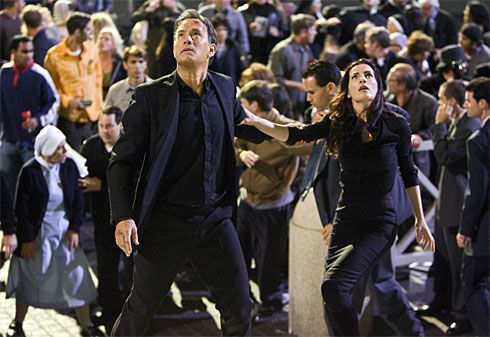Whether in two dimensions or three, Rob Letterman’s
Monsters vs. Aliens plays furiously with perspective. Numerous sequences are designed with distant vanishing points, dramatic foregrounding, and a very shallow depth of field that seems to suspend faces or objects in mid-air. Even in 2-D, the movie’s visual impact is powerful. Not only are the images beautifully and marvelously detailed (heat waves shimmering off a pavement, blades of grass, individual hairs on the belly of a gigantic mutant grub), but the thrusting forwards and backwards of blocks of color, and the film’s swooping point of view give you the strong impression of being inside the images. Even the surround sound seems to be ratcheted up a notch—almost to the point of being as clunky as a poorly set-up home speaker system—as if the visual jolts and jabs were throwing sounds into the back corners of the theater.

Playing with perspective is an important part of children’s entertainment, starting from the 1952
Borrowers books, in which a minuscule family lives among the thimbles, buttons, and teaspoons of a normal-sized house, and going on through
Stuart Little and
The Cricket in Times Square. If books tend to explore the child’s sense of smallness in an adult world (with the exception of
Gulliver’s Travels, which really shouldn’t be read by children at all, anyhow), movies tend to go the other way, playing with a child’s bafflement at the threat of growing up:
Big,
Thirteen Going on Thirty, and the forthcoming
17 Again are just a few examples. When Letterman’s own
Gulliver’s Travels film is released in 2010, it will surely express his interest in the comic and alienating potential of shifts in size and perspective.
Monsters vs. Aliens builds on this size-shifting tradition, capturing the mischief and the misery of distorted size at both ends. Susan (voiced by Reese Witherspoon) becomes the mother of all Bridezillas by expanding to enormous size after being hit by a meteor. (Interestingly, she goes from meek bride to something out of
Barbarella as she pops out of her human-sized clothes.) She is soon imprisoned along with three other monsters: Hugh Laurie’s exasperated-scientist cockroach, Will Arnett’s lizard-fish strongman, and Seth Rogen’s gurgle-voiced B.O.B. whose confused eagerness is one of the best parts of the movie. These three become Susan’s Lion, Scarecrow, and Tin Man as the story warps into
The Wizard of Oz, complete with its demonstration that the heroine’s strengths lay within her all along. While Susan/Ginormica ingeniously uses cars as roller skates and the roof of a gas station as a sitting stool, her trio of buddies, wriggles and crawls and blobs its way through small spaces. Watching the film, we are always following the point of view of someone who is the wrong size at the wrong time.
But interestingly, adults watching
Monsters vs. Aliens are always the right size. We always have the right perspective, catching all the jokes that sail over the heads of the children on booster seats in the next row. This makes sense. After all, Letterman hasn’t forgotten that children don’t drive. Someone has to bring them to the movie theater, buy their candy, and smile benignly when they address the characters on screen (e.g. the little girls at a 2007 screening of
Enchantment who answered Amy Adams’ Giselle by assuring her that she looked pretty). And so,
Monsters vs. Aliens has a general named W.R. Monger explain that the imprisonment of the monsters is a diversion to keep people compliant with the I.R.S. (Surely this is the first children’s movie to use the tax code as its premise.). The prison is a textbook image of Jeremy Bentham's
panopticon, complete with its central tower from which all the cells are visible to ever-watchful eyes. And when the President of the United States, voiced perfectly by Stephen Colbert, attempts to communicate with the alien robot, the adults will recognize the music as a pastiche of alien-encounter theme songs. The B-52s’ “It Came From Planet Claire” as background music is just icing on the cake.
The movie is so full of allusions that it risks coming across as a bit of a mess. There is no central theme here—other than, I suppose, the trite and played-out story of the stranger accepted for just who he or she is, and the band of strangers that comes together. (We’re only a small step away from “Don’t make fun of my differences,” an expression that even kids have been mocking for years.) For kids, the whole show is no doubt fun. The monsters are funny, the action is exciting, the images are surprising. For adults, the movie is a bit like a Wikipedia page, chock-full of links that take our thoughts in different directions.
Ah, but then there’s Insectosaurus, aka Insecto. A grub the size of an upended zeppelin, with stubby, comic antennae, and enormous placid eyes, Insecto has the unchanging happy face of an amusement park toy, without the creepiness. Like a giant baby, he doesn’t do much. When they need him to go somewhere, they hang a bank of stadium lights from a helicopter and use it to lure him away. He is a bit reminiscent of
Totoro, the magical creature from the children’s anime films of the same name, and in a way, he performs a similar function here.

More than any other monster fighting the legion of Rainn Wilson’s aliens, Insecto saves the day and saves the movie. I won’t go into detail here, lest I ruin the well-prepared for surprise. Suffice it to say that, in a movie at least partly about one’s sudden transformation into something else, about the bewildering distortions of one’s body, Insecto, with his imperturbable eyes and his infant smile, brings the movie’s allusiveness together and organizes it around a rather sweet conclusion.


















